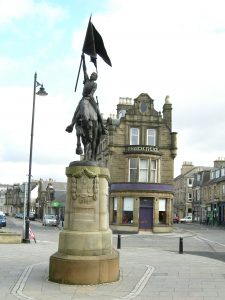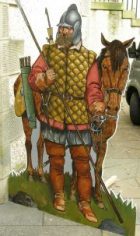Introduction
This is not meant to be a comprehensive description of the life and times of the Border Reivers. I have neither the knowledge nor the space to do justice to the subject. For those seeking more information there are detailed accounts such as “The Reivers” by Alistair Moffat; “The Steel Bonnets” by George MacDonald Fraser; and “The Border Reivers” by Godfrey Watson – all still in print. This is only a short, personal impression of what the Reivers were and why they existed when and where they did. It is intended to put a Harkness perspective on an important part of Scottish life and history.
History
For three hundred years anyone living on or near the border between England and Scotland was living in a war zone. There were no non-combatants, no civilians. Between 1296, when Edward I of England invaded Scotland to subordinate it to his rule; and 1603 when James VI of Scotland inherited the English throne; the constant threat of invasions, raids, skirmishes and attacks dictated the life style of the inhabitants of the Border. Opting out was never an option. Survival meant adopting a unique outlook and way of life.
Cross border warfare was total. Scotland, always the underdog, quickly adopted a ‘scorched earth’ policy of defence. No crops, livestock or shelter was left to support the invading army. This meant there was little point in building a substantial house when you had to burn it down on a regular basis. There was little point in accumulating personal possessions if they were only to be stolen or destroyed.
Many historians take the view that the Border Reivers were murderers and thieves. My own view is that they were people, on both sides of the border, who had no choice but to adopt a way of life that allowed them and their families to survive. Moving away was not an option at a time when mobility was almost unheard of. Most people lived and died within a few miles of where they were born. Marriage occasionally brought the need or opportunity to move, even cross border, but this was the exception. For the most part people stayed put and adapted. An important key to survival was the bond of family. This meant not just immediate family but the extended family. Affiliations arose with other “Names”, in the case of Harkness in the south-west Scotland, this appears to have been mainly with the Armstrong, Scott and Douglas families. Being part of an extended family made you less vulnerable. It meant mutual support, being less liable to attack and persecution and having the ability to retaliate if necessary.
James VI became king of the joint kingdoms of Scotland and England in 1603 and a dramatic change took place for those living close to the border. Their former way of life was seen as a threat to the integrity of the kingdom. Many who did not give up the old way of life were hanged or given the opportunity to take part in James’ Plantation or colonisation of Ulster. As well as threats, bribery of land to farm was used to encourage emigration and it was around this time that numerous Harknesses, along with many of their compatriots, moved to Northern Ireland.


